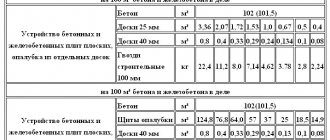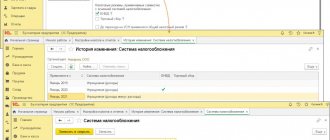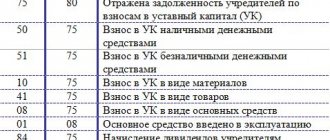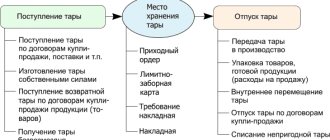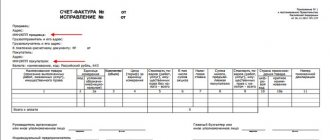Construction materials are one of the key factors in determining the cost of constructed buildings and structures. Errors in recording the receipt and write-off of construction materials in accounting affect the balance sheet and the tax base. With an incorrect approach to the assessment of materials at different stages of construction and inadequate control of their consumption, the risks of underpayments or overpayments on taxes increase.
Question: How to reflect in the accounting records of the customer organization the transfer of construction materials to the contractor to carry out work on major renovations of office premises, if, according to the contract, the work is provided with materials by the customer? Office space is included in fixed assets (fixed assets). The actual cost of materials transferred to the contractor is 400,000 rubles. Upon completion of the repair, the contractor provided the customer with a report on the consumption of materials. For the purposes of tax accounting of income and expenses, the organization uses the accrual method. View answer
Accounting in construction
The construction of buildings or structures has enormous differences from other types of activities, not only in the stages of implementation and implementation, but also in terms of accounting and tax accounting.
Differences in accounting in construction:
- Documentation. Participants use other documents to reflect the stages and results of construction. For example, certificates of completed work in the KS-2 special form, as well as a special certificate on the cost of construction in the KS-3 form.
- Cost accounting by elements. In other words, the costs incurred are divided into several elements, such as: materials, wages of specialists, operation of equipment, machinery and mechanisms, as well as overhead costs.
- Features of object acceptance. The completed construction project is subject to acceptance according to special rules and special commissions; based on the results of this control event, a transfer and acceptance certificate is drawn up (form No. OS-1a).
- The need to register the object. The constructed building is subject to mandatory registration with the relevant government agencies. Only after registration an object can be included in fixed assets.
Moreover, accounting in the customer’s company also differs from accounting in the contractor’s organization. Let's take a closer look at the accounting features for each party.
Accounting for other disposals (write-offs, gratuitous transfers) of materials. Accounting entries
Write-off of materials can be carried out in the following cases:
- that have become unusable after expiration of the storage period;
- obsolete;
- when identifying shortages, thefts or damage, including due to accidents, fires, and natural disasters.
The preparation of the necessary information for making a decision on the write-off of materials is carried out by the Commission with the participation of financially responsible persons. Based on the results of the inspection, the Commission draws up an Act on the write-off of materials for each division of the organization, for financially responsible persons.
The write-off of materials transferred under a gift agreement or free of charge is carried out on the basis of primary documents for the release of materials (waybills, applications for the release of materials to third parties, etc.). Article 146 “Object of taxation” of the Tax Code of the Russian Federation states that the transfer of ownership of assets free of charge is recognized as a sale, that is, subject to VAT.
Below are accounting entries reflecting the write-off and gratuitous transfer of materials
| Account Dt | Kt account | Wiring Description | Transaction amount | A document base |
| Accounting for shortages (damage) of materials in the presence of culprits | ||||
| 94 | 10 | The write-off of the book value of materials is reflected based on the write-off report drawn up by the commission | Actual cost of written-off materials | Material write-off act |
| 20 | 94 | The write-off of shortages (losses from spoilage) of materials is reflected within the approved norms of natural loss due to the expenses of the main production | Natural loss rate | Accounting certificate-calculation Act of write-off of materials |
| 23 | 94 | The write-off of shortages (losses from spoilage) of materials is reflected within the approved norms of natural loss due to the costs of auxiliary production | Natural loss rate | Accounting certificate-calculation Act of write-off of materials |
| 25 | 94 | The write-off of shortages (losses from spoilage) of materials is reflected within the approved norms of natural loss at the expense of overhead costs | Natural loss rate | Accounting certificate-calculation Act of write-off of materials |
| 26 | 94 | The write-off of shortages (losses from spoilage) of materials is reflected within the approved norms of natural loss at the expense of general business expenses | Natural loss rate | Accounting certificate-calculation Act of write-off of materials |
| 29 | 94 | The write-off of shortages (losses from spoilage) of materials is reflected within the approved norms of natural loss due to the costs of service industries | Natural loss rate | Accounting certificate-calculation Act of write-off of materials |
| 73.2 | 94 | The write-off of shortages (losses from spoilage) of materials to the perpetrators in excess of the norms of natural loss is reflected | The amount of excess of the norm of natural loss | Accounting certificate-calculation Act of write-off of materials |
| 91.2 | 68.2 | VAT, previously claimed for deduction, was restored for shortages (losses) of materials in excess of the norms of natural loss | VAT amount | Accounting certificate-calculationInvoice |
| 50.01 | 73.2 | Repayment by the guilty person of the debt for cash shortages is reflected | Shortfall amount | Receipt cash order. Form No. KO-1 |
| 70 | 73.2 | Repayment by the guilty person of the debt for shortfalls at the expense of wages is reflected | Shortfall amount | Accounting certificate-calculation |
| Features of accounting for shortages (damage) of materials in the absence of perpetrators. In this situation, the amount exceeding the natural loss rate is written off not to account 73, but to account 91 | ||||
| 91.2 | 94 | Reflects the write-off of shortages (losses from spoilage) of materials in excess of the norms of natural loss in the absence of guilty persons or shortages, the recovery of which was refused by the court | The amount of excess of the norm of natural loss | Accounting certificate-calculation Act of write-off of materials |
| Accounting for material loss due to natural disasters | ||||
| 99 | 10 | Recorded write-off of materials lost as a result of natural disasters | Cost of lost materials | Material write-off act |
| 99 | 68.2 | VAT, previously claimed for deduction, was restored on lost materials | VAT amount | Accounting certificate-calculationInvoice |
| Accounting for free transfer of materials | ||||
| 91.2 | 10 | Disposal of materials reflected | Actual cost of materials | Invoice (TMF No. M-15) Invoice |
| 91.2 | 68.2 | VAT is charged to the budget on the cost of materials donated free of charge | VAT amount | Invoice (TMF No. M-15) Invoice Sales book |
Accounting in construction for a contractor
Keeping records of construction activities of organizations is enshrined in PBU 9/99, PBU 10/99, PBU 2/94, PBU for investment accounting. All costs in a construction company are subject to division into the elements mentioned above.
To reflect construction costs in accounting, accounting account 20 “Main production” is used. The debit of account 20 reflects the following expenses:
- for materials with simultaneous reflection of costs on the credit of account 10 “Material inventories”;
- for the salary of construction company personnel under loan 70 “Payroll calculations”;
- for settlements with suppliers on account credit 60.
When receiving step-by-step acceptance, you should use account 46 “Completed stages of work in progress”, forming the posting Dt 46 Kt 90 - the work in progress is reflected.
What about materials?
In the process of working towards making a profit, business entities are often faced with the need to purchase related materials. This type of property is of low value and is rarely purchased for the purpose of further resale. Inventory inventories (MPI) are used for production or management needs.
The procedure for accounting and movement of materials must be reflected in the accounting policy of the enterprise, which each business entity has the right to form independently, without violating the requirements of current legislation. The rules for using information on materials are regulated by PBU 5/01 “Accounting for inventories”, approved by order of the Ministry of Finance of the Russian Federation dated 06/09/2001 No. 44n.
Important! From 01/01/2021 PBU 5/01 loses force, and the accounting rules are regulated by the new FSBU 5/2019 “Inventories”. Some accounting rules have been changed significantly. A ready-made solution from ConsultantPlus will help you rebuild your materials accounting. Get trial access to K+ for free and proceed to the material.
Also, on the basis of PBU 6/01 “Accounting for fixed assets”, approved by order of the Ministry of Finance of the Russian Federation dated March 30, 2001 No. 26n, equipment whose cost does not exceed 40 thousand rubles is included in the inventory.
Read about the nuances of accounting for assets whose value is below 100,000 rubles here.
Accounting in a construction organization: an example
Vesna LLC provides construction services. A contract was concluded for the construction of an office building. Acceptance is carried out in two stages: the first in the amount of 2 million rubles, the second - 2.4 million.
The terms of the contract provide for an advance payment of 90% of the cost of the stage. So, the advance for the first is 1.8 million rubles, for the second - 2.16 million rubles.
The start of work is February 2021, the end of the first part of construction is May, the second is July.
The cost price for the first is 1.72 million rubles, for the second - 1.98 million rubles.
Accounting entries:
| Period | Debit | Credit | Amount (rub.) | Operations |
| 20.02 | 51 | 62-1 | 1 800 000 | Advance payment for stage 1 of work is credited to the current account |
| 20.02 | 62-1 | 68-1 | 274 576 | VAT charged on advance payment |
| 25.03 | 46 | 90-1 | 2 000 000 | Completion of the first stage of construction, KS-2 signed |
| 25.03 | 90-3 | 68-1 | 305 085 | VAT charged |
| 25.03 | 68-1 | 62-1 | 274 576 | VAT on advance has been restored |
| 25.03 | 90-2 | 20 | 1 720 000 | The cost of the first stage of work has been written off |
| 25.03 | 90-9 | 99 | 100 610 | Profit accrued from acceptance of the first stage of work |
| 15.07 | 51 | 62-1 | 2 160 000 | The second advance was credited to the bank account |
| 15.07 | 62-1 | 68-1 | 486 000 | VAT charged on the second prepayment |
| 20.07 | 62 | 46 | 2 000 000 | The cost of construction work of the first stage was written off |
| 20.07 | 62 | 90-1 | 2 400 000 | Revenue reflected |
| 20.07 | 90-3 | 68 | 366 102 | VAT charged |
| 20.07 | 68 | 62-1 | 486 000 | VAT on prepayment has been restored |
| 20.07 | 90-2 | 20 | 1 980 000 | The cost of the second stage is written off |
| 20.07 | 90-9 | 99 | 420 000 | Profit from the second stage of work performed is reflected |
| 20.07 | 62-1 | 62 | 3 960 000 | The amount of the received advance payment is credited |
BASIC
When calculating income tax, the contractor has the right to reduce the proceeds under a construction contract by the amount of expenses associated with the performance of work (subclause 1, clause 3, article 315 of the Tax Code of the Russian Federation). In tax accounting, expenses under a construction contract are reflected in the same way as under other contracts related to the performance of work. For more information, see:
- How to take into account when calculating income tax income and expenses from the sale of manufactured products (works, services);
- How to take into account expenses related to several reporting periods when calculating income tax.
On the application of VAT deductions for goods (works, services) purchased for contract work, see Under what conditions can input VAT be deducted.
Control over the write-off of materials at the enterprise
To calculate the volume of special materials required for the construction of any facility, norms and rules approved by the production and technical department (PTO) are used.
The director of the company approves the list of employees involved in writing off inventory items. As a rule, an engineer and an accounting employee are appointed to be responsible for preparing the relevant documentation - heads of production sites who are responsible for approving the indicators indicated in the reports.
Moreover, the responsibility for signing the processed documents of the chief engineer and the head of the technical department should also be stated in the same order.
The accounting department is assigned the following functions:
- preventing the write-off of building materials in quantities exceeding the standards;
- preventing the groundless write-off of construction material due to loss;
- eliminating fraud based on the write-off of special material of a higher level than was actually used.
Any construction company striving for correct and accurate accounting of building materials must build a clear document flow system.
simplified tax system
If an organization applies a simplification and pays a single tax on income, then expenses under a construction contract will not reduce the tax base. This is due to the fact that such organizations do not take into account any expenses at all (clause 1 of Article 346.18 of the Tax Code of the Russian Federation).
If an organization pays a single tax on the difference between income and expenses, proceeds from the sale of contract work can be reduced by the amount of expenses associated with their implementation (clause 2 of Article 346.18 of the Tax Code of the Russian Federation). In this case, take into account only those expenses that are named in paragraph 1 of Article 346.16 of the Tax Code of the Russian Federation. Such expenses may include, in particular:
- material costs;
- labor costs;
- the amount of “input” VAT paid to suppliers, etc.
For more information about accounting for expenses when simplifying, see What expenses should be taken into account when calculating the single tax on the simplified tax system.
